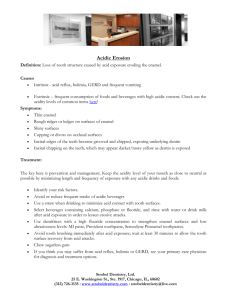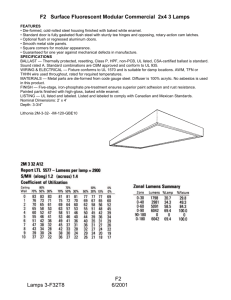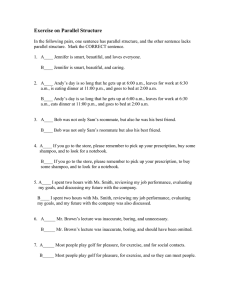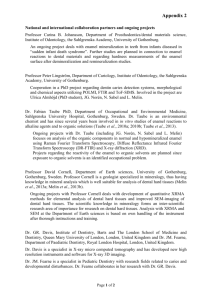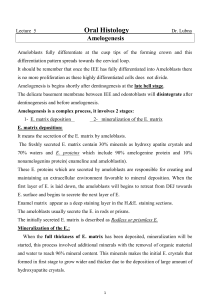Amelogenesis
advertisement
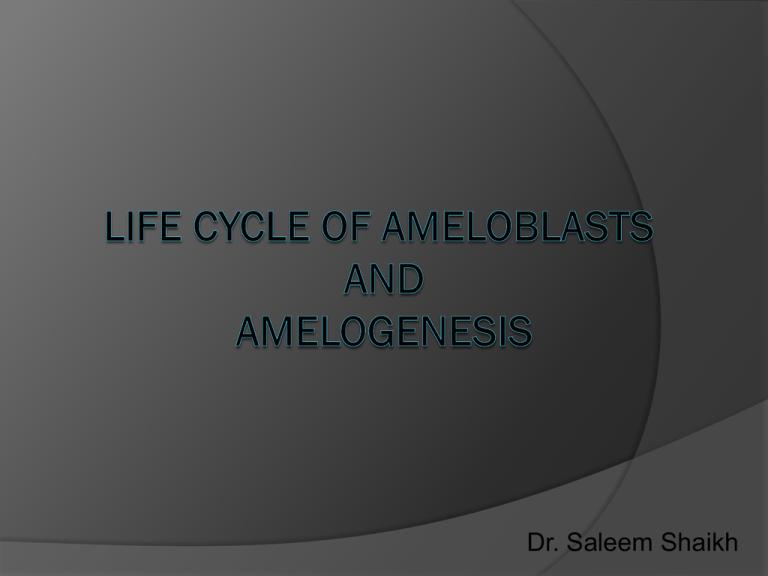
Dr. Saleem Shaikh Introduction The development of tooth is divided into stages – bud, cap, early bell and advanced bell stage Enamel organ consists of 4 layers – outer enamel epithelium, inner enamel epithelium, stratum intermedium, stellate reticulum. The cells of the inner enamel epithelium become more columnar and convert into ameloblasts, which produce enamel. Enamel formation begins in the advanced bell stage. Life cycle of Ameloblasts Divided into six stages: Morphogenic stage Organizing stage Formative stage Maturative stage Protective stage Desmolytic stage Amelogenesis occurs during formative and maturative stage. Ameloblasts start differentiating from the tips of cusps or incisal region and progresses towards the cervical region. Morphogenic stage This is the first stage The cells are short and columnar with nucleus which fills up almost the entire cell body The golgi apparatus and centrioles are located in the proximal end – near stratum intermedium Mitochondria are present throughout the cytoplasm Organizing stage Ameloblasts interact with the adjacent connective tissue. Odontoblast form in the dental papilla Ameloblasts become longer and reversal of functional polarity takes place; nucleus moves towards the top part (proximal) and centrioles – golgi apparatus moves towards the lower part (distal end). During the last phase of organizing phase dentin formation is seen Reversal of nutrition of ameloblasts Formative stage This stage begins after formation of 1st layer of dentin – reciprocal induction Ameloblasts develop a blunt process at their end which is known as tomes process Enamel matrix is laid down durng this stage, but the enamel matrix is rich in organic constituents and is later modified to reach its final form. Tomes process contain secretory granules as well as rough endoplasmic reticulum. The tomes process appear to be separate from the rest of the cell by a structure known as DISTAL TERMINAL BAR. Maturative stage During this stage ameloblasts are slightly reduced in length and are closely attached to the enamel surface. The cells absorb organic material from the matrix and infuse inorganic elements into the matrix. Two phases of ameloblasts seen in this stage Smooth end Ruffled border (microvilli) Calcium is actively pumped during ruffel ended phase and passively during smooth ended phase Proteases are secreted by ameloblasts which degrades the enamel proteins and these are absorbed by the ruffle ended ameloblasts. More than 90% of the initially secreted protein is lost during enamel maturation. Protective stage When enamel is completely calcified the ameloblasts become small and fuse with the other layers of enamel organ. i.e. outer enamel epithelium, stellate reticulum and stratum intermedium. All these layers together form a covering over the enamel and this is known as REDUCED ENAMEL EPITHELIUM Its function is to prevent the mature enamel from coming in contact with the connective tissue (dental follicle). If enamel comes in contact with the dental follicle then cementum may deposit on top of enamel. Desmolytic stage During eruption the reduced enamel epithelium releases enzymes which tend to cause the atrophy of the connective tissue so that the tooth can erupt through the oral mucosa. The reduced enamel epithelium fuses with the oral epithelium and this helps in the tooth eruption without any bleeding. Premature degeneration of the reduced enamel epithelium may prevent the eruption of the tooth. Amelogenesis This process is divided into two parts Formation of enamel matrix Mineralization and maturation of enamel matrix Enamel matrix: enamel matrix is initially deposited as small islands and then it forms a continous layer Amelogenin is the major component of enamel matrix proteins. It maintains the space between enamel crystals. Absence of this protein results in hypoplastic teeth. Ameloblastin and enamelin are other important proteins of enamel. These help in growth of crystals. Tuftelin is another protein which is seen only near the dentinoenamel junction. Mineralization of enamel matrix takes place in two stages. Immediate partial mineralization Maturation Nucleation is initiated when enamel matrix comes in contact of the crystals of dentin. Maturation is completed by gradually by removing organic and deposition of inorganic material The process of matrix formation, mineralisation and maturation starts from the cusp tips and progresses towards the cervical region. It also starts from the dentinoenamel junction and proceeds towards the surface.

